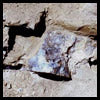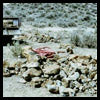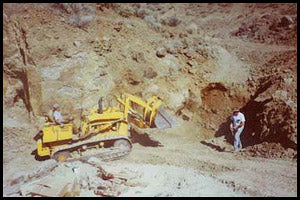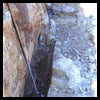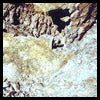Graveyard Point Plume Agate Mining Operation 2000
Graveyard Point Plume Agate is a well-known seam agate found in far eastern Oregon. The area is only seven miles from Homedale, Idaho and just two miles across the Idaho-Oregon border. Agate enthusiasts have collected here for over 40 years and still do. There have been numerous commercial mining operations in the past, and there are 3 or 4 claims in the area now (Aug. 2000). Even with these claims there is ample area for free collecting and everyone who seeks agate here will find something.
The Gem Shop, Inc. filed a claim here in 1996 several years after some old claims were dropped. Detail from specimen above The land claimed covers parts of two old claims. One had the deposit that was mined and sold as Regency Rose Plume Agate. The other was known for a yellow plume in blue agate that was mined in the ‘70’s by the late Tom Caldwell. These two areas are about 150 yards apart on opposite sides of a flat ridge. Our plans are to mine the yellow plume in the summer of 2000, and get started mining on the pink plume (Regency Rose) in 2001. We moved our equipment to the claim in early June and have been working ever since. Jake, my partner, is working now and expects to continue mining through September.
Graveyard Point Plume Agate forms in cracks in the local basalt. The basalt is cracked extensively for several square miles, and on our claim there is an agate vein about every 10 feet or so. The veins can be from one inch to about 18 inches thick, and extend from a few feet to 30 feet in length. They can go in any direction but most veins are vertical. During the formation of the agate many of the cracks in the basalt did not completely fill in. This results in small cave like structures filled with angel wing chalcedony.
Angel wing chalcedony refers to feathery stalactitic growths that cover the inside of the agate seam. This is the plume formation in the agate without the complete agate covering. The Graveyard Point area is well known for angel wing chalcedony. Many specimens have delicately curved tips and look like they were blown in the wind. Besides blue, they can be tinted red, orange or even green. The plumes in this deposit grow from the sides of the seam toward the center. Most small plumes, and plumes near the edge of the seams, are white. Larger plumes can be brown, yellow, orange, pink, or reddish in color. Black dendrites can also accompany the plumes. Marcassite inclusions are also common and can "dust" the surface of one side of a plume like wind driven snow on a pine tree. Sometimes the plumes are totally marcassite. Most of the plumes are formed in a clear to light blue agate although sometimes amber colored agate is found. The mining challenge is to find a vein with well-defined colorful plumes.



